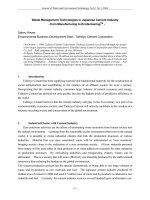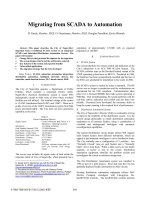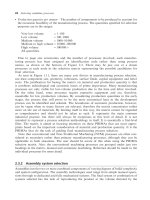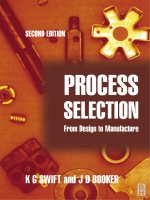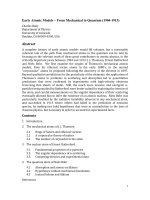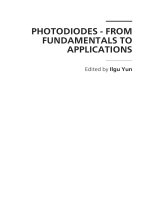- Trang chủ >>
- Khoa Học Tự Nhiên >>
- Vật lý
Great physicists from galileo to hawking w cropper
Bạn đang xem bản rút gọn của tài liệu. Xem và tải ngay bản đầy đủ của tài liệu tại đây (7.13 MB, 512 trang )
Great PhysicistsGreat Physicists
The Life and Times of Leading Physicists
from Galileo to Hawking
William H. Cropper
1
2001
1
Oxford New York
Athens Auckland Bangkok Bogota´ Buenos Aires
Cape Town Chennai Dar es Salaam Delhi Florence Hong Kong Istanbul
Karachi Kolkata Kuala Lumpur Madrid Melbourne Mexico City Mumbai
Nairobi Paris Sao Paulo Shanghai Singapore Taipei Tokyo Toronto Warsaw
and associated companies in
Berlin Ibadan
Copyright ᭧ 2001 by Oxford University Press, Inc.
Published by Oxford University Press, Inc.
198 Madison Avenue, New York, New York 10016
Oxford is a registered trademark of Oxford University Press
All rights reserved. No part of this publication may be reproduced,
stored in a retrieval system, or transmitted, in any form or by any means,
electronic, mechanical, photocopying, recording, or otherwise,
without the prior permission of Oxford University Press.
Library of Congress Cataloging-in-Publication Data
Cropper, William H.
Great Physicists: the life and times of leading physicists from Galileo to Hawking /
William H. Cropper.
p. cm Includes bibliographical references and index.
ISBN 0–19–513748–5
1. Physicists—Biography. I. Title.
QC15 .C76 2001 530'.092'2—dc21 [B] 2001021611
987654321
Printed in the United States of America
on acid-free paper
Contents
Preface ix
Acknowledgments xi
I. Mechanics
Historical Synopsis 3
1. How the Heavens Go 5
Galileo Galilei
2. A Man Obsessed 18
Isaac Newton
II. Thermodynamics
Historical Synopsis 41
3. A Tale of Two Revolutions 43
Sadi Carnot
4. On the Dark Side 51
Robert Mayer
5. A Holy Undertaking 59
James Joule
6. Unities and a Unifier 71
Hermann Helmholtz
7. The Scientist as Virtuoso 78
William Thomson
8. The Road to Entropy 93
Rudolf Clausius
9. The Greatest Simplicity 106
Willard Gibbs
10. The Last Law 124
Walther Nernst
III. Electromagnetism
Historical Synopsis 135
11. A Force of Nature 137
Michael Faraday
vi Contents
12. The Scientist as Magician 154
James Clerk Maxwell
IV. Statistical Mechanics
Historical Synopsis 177
13. Molecules and Entropy 179
Ludwig Boltzmann
V. Relativity
Historical Synopsis 201
14. Adventure in Thought 203
Albert Einstein
VI. Quantum Mechanics
Historical Synopsis 229
15. Reluctant Revolutionary 231
Max Planck
16. Science by Conversation 242
Niels Bohr
17. The Scientist as Critic 256
Wolfgang Pauli
18. Matrix Mechanics 263
Werner Heisenberg
19. Wave Mechanics 275
Erwin Schro¨ dinger and Louis de Broglie
VII. Nuclear Physics
Historical Synopsis 293
20. Opening Doors 295
Marie Curie
21. On the Crest of a Wave 308
Ernest Rutherford
22. Physics and Friendships 330
Lise Meitner
23. Complete Physicist 344
Enrico Fermi
Contents vii
VIII. Particle Physics
Historical Synopsis 363
24. i
γ
.
ץ ϭ
m
365
Paul Dirac
25. What Do You Care? 376
Richard Feynman
26. Telling the Tale of the Quarks 403
Murray Gell-Mann
IX. Astronomy, Astrophysics, and Cosmology
Historical Synopsis 421
27. Beyond the Galaxy 423
Edwin Hubble
28. Ideal Scholar 438
Subrahmanyan Chandrasekhar
29. Affliction, Fame, and Fortune 452
Stephen Hawking
Chronology of the Main Events 464
Glossary 469
Invitation to More Reading 478
Index 485
This book tells about lives in science, specifically the lives of thirty from the
pantheon of physics. Some of the names are familiar (Newton, Einstein, Curie,
Heisenberg, Bohr), while others may not be (Clausius, Gibbs, Meitner, Dirac,
Chandrasekhar). All were, or are, extraordinary human beings, at least as fasci-
nating as their subjects. The short biographies in the book tell the stories of both
the people and their physics.
The chapters are varied in format and length, depending on the (sometimes
skimpy) biographical material available. Some chapters are equipped with short
sections (entitled “Lessons”) containing background information on topics in
mathematics, physics, and chemistry for the uninformed reader.
Conventional wisdom holds that general readers are frightened of mathemat-
ical equations. I have not taken that advice, and have included equations in some
of the chapters. Mathematical equations express the language of physics: you
can’t get the message without learning something about the language. That
should be possible if you have a rudimentary (high school) knowledge of algebra,
and, if required, you pay attention to the “Lessons” sections. The glossary and
chronology may also prove helpful. For more biographical material, consult the
works cited in the “Invitation to More Reading” section.
No claim is made that this is a comprehensive or scholarly study; it is intended
as recreational reading for scientists and students of science (formal or informal).
My modest hope is that you will read these chapters casually and for entertain-
ment, and learn the lesson that science is, after all, a human endeavor.
William H. Cropper
It is a pleasure to acknowledge the help of Kirk Jensen, Helen Mules, and Jane
Lincoln Taylor at Oxford University Press, who made an arduous task much more
pleasant than it might have been. I Am indebted to my daughters, Hazel and
Betsy, for many things, this time for their artistry with computer software and
hardware.
I am also grateful for permission to reprint excerpts from the following
publications:
Subtle is the Lord: The Science and Life of Albert Einstein, by Abraham Pais,
copyright ᭧ 1983 by Abraham Pais. Used by permission of Oxford University
Press, Inc.; The Quantum Physicists, by William H. Cropper, copyright ᭧ 1970
by Oxford University Press, Inc. Used by permission of Oxford University Press,
Inc.; Ludwig Boltzmann:The Man Who Trusted Atoms, by Carlo Cercignani, copy-
right ᭧ 1998 by Carlo Cercignani. Used by permission of Oxford University Press,
Inc.; Lise Meitner: A Life in Physics, by Ruth Lewin Sime, copyright ᭧ 1996 by
the Regents of the University of California. Used by permission of the University
of California Press; Marie Curie: A Life, by Susan Quinn, copyright ᭧ 1996, by
Susan Quinn. Used by permission of the Perseus Books Group; Atoms in the
Family: My Life with Enrico Fermi, by Laura Fermi, copyright ᭧ 1954 by The
University of Chicago. Used by permission of The University of Chicago Press;
Enrico Fermi, Physicist, by Emilio Segre`, copyright ᭧ 1970 by The University of
Chicago. Used by permission of The University of Chicago Press; Strange Beauty:
Murray Gell-Mann and the Revolution in Twentieth-Century Physics, by George
Johnson, copyright ᭧ 1999 by George Johnson. Used by permission of Alfred A.
Knopf, a division of Random House, Inc. Also published in the United Kingdom
by Jonathan Cape, and used by permission from the Random House Group, Lim-
ited; QED and the Men Who Made It, by Silvan S. Schweber, copyright ᭧ 1994
by Princeton University Press. Used by permission of Princeton University Press;
Surely You’re Joking, Mr. Feynman by Richard Feynman as told to Ralph Leigh-
ton, copyright ᭧ 1985 by Richard Feynman and Ralph Leighton. Used by per-
mission of W.W. Norton Company, Inc. Also published in the United Kingdom
by Century, and used by permission from the Random House Group, Limited;
What Do You Care What Other People Think?, by Richard Feynman as told to
Ralph Leighton, copyright ᭧ 1988 by Gweneth Feynman and Ralph Leighton.
Used by permission of W.W. Norton Company, Inc.; The Feynman Lectures on
Physics, by Richard Feynman, Robert Leighton, and Matthew Sands, copyright
᭧ 1988 by Michelle Feynman and Carl Feynman. Used by permission of the
Perseus Books Group; Chandra: A Biography of S. Chandrasekhar, by Kameshwar
Wali, copyright ᭧ 1991 by The University of Chicago. Used by permission of The
University of Chicago Press; Edwin Hubble: Mariner of the Nebulae, by Gale E.
Christianson, copyright ᭧ 1995 by Gale E. Christianson. Used by permission of
xii Acknowledgments
Farrar, Straus and Giroux, L.L.C. Published in the United Kingdom by the Insti-
tute of Physics Publishing. Used by permission of the Institute of Physics Pub-
lishing; ‘‘Rudolf Clausius and the Road to Entropy,’’ by William H. Cropper,
American Journal of Physics 54, 1986, pp. 1068–1074, copyright ᭧ 1986 by the
American Association of Physics Teachers. Used by permission of the American
Institute of Physics; ‘‘Walther Nernst and the Last Law,’’ by William H. Cropper,
Journal of Chemical Education 64, 1987, pp. 3–8, copyright ᭧ 1987 by the Di-
vision of Chemical Education, American Chemical Society. Used by permission
of the Journal of Chemical Education; ‘‘Carnot’s Function, Origins of the Ther-
modynamic Concept of Temperature,’’ by William H. Cropper, American Journal
of Physics 55, 1987, pp. 120–129, copyright ᭧ 1987 by the American Association
of Physics Teachers. Used by permission of the American Institute of Physics;
‘‘James Joule’s Work in Electrochemistry and the Emergence of the First Law of
Thermodynamics,’’ by William H. Cropper, Historical Studies in the Physical and
Biological Sciences 19, 1986, pp. 1–16, copyright ᭧ 1988 by the Regents of the
University of California. Used by permission of the University of California Press.
All of the portrait photographs placed below the chapter headings were sup-
plied by the American Institute of Physics Emilio Segre` Visual Archives, and are
used by permission of the American Institute of Physics. Further credits are:
Chapter 2 (Newton), Massachusetts Institute of Technology Burndy Library;
Chapter 4 (Mayer), Massachusetts Institute of Technology Burndy Library; Chap-
ter 5 (Joule), Physics Today Collection; Chapter 7 (Thomson), Zeleny Collection;
Chapter 8 (Clausius), Physics Today Collection; Chapter 10 (Nernst), Photograph
by Francis Simon; Chapter 11 (Faraday), E. Scott Barr Collection; Chapter 13
(Boltzmann), Physics Today Collection; Chapter 14 (Einstein), National Archives
and Records Administration; Chapter 16 (Bohr), Segre` Collection; Chapter 19
(Schro¨dinger), W.F. Meggers Collection; Chapter 20 (Curie), W. F. Meggers Col-
lection; Chapter 21 (Rutherford), Nature; Chapter 22 (Meitner), Herzfeld Collec-
tion; Chapter 23 (Fermi), Fermi Film Collection; Chapter 24 (Dirac), photo by A.
Bo¨rtzells Tryckeri; Chapter 25 (Feynman), WGBH-Boston; Chapter 26 (Gell-
Mann), W.F. Meggers Collection; Chapter 27 (Hubble), Hale Observatories; Chap-
ter 28 (Chandrasekhar), K.G. Somsekhar, Physics Today Collection; Chapter 29
(Hawking), Physics Today Collection.
MECHANICS
Historical Synopsis
Physics builds from observations. No physical theory can succeed if
it is not confirmed by observations, and a theory strongly supported
by observations cannot be denied. For us, these are almost truisms.
But early in the seventeenth century these lessons had not yet been
learned. The man who first taught that observations are essential and
supreme in science was Galileo Galilei.
Galileo first studied the motion of terrestrial objects, pendulums,
free-falling balls, and projectiles. He summarized what he observed
in the mathematical language of proportions. And he extrapolated
from his experimental data to a great idealization now called the
“inertia principle,” which tells us, among other things, that an object
projected along an infinite, frictionless plane will continue forever at
a constant velocity. His observations were the beginnings of the
science of motion we now call “mechanics.”
Galileo also observed the day and night sky with the newly
invented telescope. He saw the phases of Venus, mountains on the
Moon, sunspots, and the moons of Jupiter. These celestial
observations dictated a celestial mechanics that placed the Sun at
the center of the universe. Church doctrine had it otherwise: Earth
was at the center. The conflict between Galileo’s telescope and
Church dogma brought disaster to Galileo, but in the end the
telescope prevailed, and the dramatic story of the confrontation
taught Galileo’s most important lesson.
Galileo died in 1642. In that same year, his greatest successor,
Isaac Newton, was born. Newton built from Galileo’s foundations a
system of mechanics based on the concepts of mass, momentum,
and force, and on three laws of motion. Newton also invented a
mathematical language (the “fluxion” method, closely related to our
present-day calculus) to express his mechanics, but in an odd
historical twist, rarely applied that language himself.
Newton’s mechanics had—and still has—cosmic importance. It
applies to the motion of terrestrial objects, and beyond that to
planets, stars, and galaxies. The grand unifying concept is Newton’s
theory of universal gravitation, based on the concept that all objects,
4 Great Physicists
small, large, and astronomical (with some exotic exceptions), attract
one another with a force that follows a simple inverse-square law.
Galileo and Newton were the founders of modern physics. They
gave us the rules of the game and the durable conviction that the
physical world is comprehensible.
1
How the Heavens Go
Galileo Galilei
The Tale of the Tower
Legend has it that a young, ambitious, and at that moment frustrated mathematics
professor climbed to the top of the bell tower in Pisa one day, perhaps in 1591,
with a bag of ebony and lead balls. He had advertised to the university com-
munity at Pisa that he intended to disprove by experiment a doctrine originated
by Aristotle almost two thousand years earlier: that objects fall at a rate propor-
tional to their weight; a ten-pound ball would fall ten times faster than a one-
pound ball. With a flourish the young professor signaled to the crowd of amused
students and disapproving philosophy professors below, selected balls of the
same material but with much different weights, and dropped them. Without air
resistance (that is, in a vacuum), two balls of different weights (and made of any
material) would have reached the ground at the same time. That did not happen
in Pisa on that day in 1591, but Aristotle’s ancient principle was clearly violated
anyway, and that, the young professor told his audience, was the lesson. The
students cheered, and the philosophy professors were skeptical.
The hero of this tale was Galileo Galilei. He did not actually conduct that
“experiment” from the Tower of Pisa, but had he done so it would have been
entirely in character. Throughout his life, Galileo had little regard for authority,
and one of his perennial targets was Aristotle, the ultimate authority for univer-
sity philosophy faculties at the time. Galileo’s personal style was confronta-
tional, witty, ironic, and often sarcastic. His intellectual style, as the Tower
story instructs, was to build his theories with an ultimate appeal to obser-
vations.
The philosophers of Pisa were not impressed with either Galileo or his meth-
ods, and would not have been any more sympathetic even if they had witnessed
the Tower experiment. To no one’s surprise, Galileo’s contract at the University
of Pisa was not renewed.
6 Great Physicists
Padua
But Galileo knew how to get what he wanted. He had obtained the Pisa post with
the help of the Marquis Guidobaldo del Monte, an influential nobleman and
competent mathematician. Galileo now aimed for the recently vacated chair of
mathematics at the University of Padua, and his chief backer in Padua was Gian-
vincenzio Pinelli, a powerful influence in the cultural and intellectual life of
Padua. Galileo followed Pinelli’s advice, charmed the examiners, and won the
approval of the Venetian senate (Padua was located in the Republic of Venice,
about twenty miles west of the city of Venice). His inaugural lecture was a
sensation.
Padua offered a far more congenial atmosphere for Galileo’s talents and life-
style than the intellectual backwater he had found in Pisa. In the nearby city of
Venice, he found recreation and more—aristocratic friends. Galileo’s favorite de-
bating partner among these was Gianfrancesco Sagredo, a wealthy nobleman with
an eccentric manner Galileo could appreciate. With his wit and flair for polemics,
Galileo was soon at home in the city’s salons. He took a mistress, Marina Gamba,
described by one of Galileo’s biographers, James Reston, Jr., as “hot-tempered,
strapping, lusty and probably illiterate.” Galileo and Marina had three children:
two daughters, Virginia and Livia, and a son, Vincenzo. In later life, when tragedy
loomed, Galileo found great comfort in the company of his elder daughter,
Virginia.
During his eighteen years in Padua (1592–1610), Galileo made some of his
most important discoveries in mechanics and astronomy. From careful observa-
tions, he formulated the “times-squared” law, which states that the vertical dis-
tance covered by an object in free fall or along an inclined plane is proportional
to the square of the time of the fall. (In modern notation, the equation for free
fall is expressed , with s and t the vertical distance and time of the fall,
2
gt
s ϭ
2
and g the acceleration of gravity.) He defined the laws of projected motion with
a controlled version of the Tower experiment in which a ball rolled down an
inclined plane on a table, then left the table horizontally or obliquely and
dropped to the floor. Galileo found that he could make calculations that agreed
approximately with his experiments by resolving projected motion into two com-
ponents, one horizontal and the other vertical. The horizontal component was
determined by the speed of the ball when it left the table, and was “conserved”—
that is, it did not subsequently change. The vertical component, due to the ball’s
weight, followed the times-squared rule.
For many years, Galileo had been fascinated by the simplicity and regularity
of pendulum motion. He was most impressed by the constancy of the pendulum’s
“period,” that is, the time the pendulum takes to complete its back-and-forth
cycle. If the pendulum’s swing is less than about 30Њ, its period is, to a good
approximation, dependent only on its length. (Another Galileo legend pictures
him as a nineteen-year-old boy in church, paying little attention to the service,
and timing with his pulse the swings of an oil lamp suspended on a wire from
a high ceiling.) In Padua, Galileo confirmed the constant-period rule with exper-
iments, and then uncovered some of the pendulum’s more subtle secrets.
In 1609, word came to Venice that spectacle makers in Holland had invented
an optical device—soon to be called a telescope—that brought distant objects
Galileo Galilei 7
much closer. Galileo immediately saw a shining opportunity. If he could build a
prototype and demonstrate it to the Venetian authorities before Dutch entrepre-
neurs arrived on the scene, unprecedented rewards would follow. He knew
enough about optics to guess that the Dutch design was a combination of a con-
vex and a concave lens, and he and his instrument maker had the exceptional
skill needed to grind the lenses. In twenty-four hours, according to Galileo’s own
account, he had a telescope of better quality than any produced by the Dutch
artisans. Galileo could have demanded, and no doubt received, a large sum for
his invention. But fame and influence meant more to him than money. In an
elaborate ceremony, he gave an eight-power telescope to Niccolo` Contarini, the
doge of Venice. Reston, in Galileo, paints this picture of the presentation of the
telescope: “a celebration of Venetian genius, complete with brocaded advance
men, distinguished heralds and secret operatives. Suddenly, the tube represented
the flowering of Paduan learning.” Galileo was granted a large bonus, his salary
was doubled, and he was reappointed to his faculty position for life.
Then Galileo turned his telescope to the sky, and made some momentous, and
as it turned out fateful, discoveries. During the next several years, he observed
the mountainous surface of the Moon, four of the moons of Jupiter, the phases
of Venus, the rings of Saturn (not quite resolved by his telescope), and sunspots.
In 1610, he published his observations in The Starry Messenger, which was an
immediate sensation, not only in Italy but throughout Europe.
But Galileo wanted more. He now contrived to return to Tuscany and Florence,
where he had spent most of his early life. The grand duke of Tuscany was the
young Cosimo de Medici, recently one of Galileo’s pupils. To further his cause,
Galileo dedicated The Starry Messenger to the grand duke and named the four
moons of Jupiter the Medicean satellites. The flattery had its intended effect.
Galileo soon accepted an astonishing offer from Florence: a salary equivalent to
that of the highest-paid court official, no lecturing duties—in fact, no duties of
any kind—and the title of chief mathematician and philosopher for the grand
duke of Tuscany. In Venice and Padua, Galileo left behind envy and bitterness.
Florence and Rome
Again the gregarious and witty Galileo found intellectual companions among the
nobility. Most valued now was his friendship with the young, talented, and skep-
tical Filippo Salviati. Galileo and his students were regular visitors at Salviati’s
beautiful villa fifteen miles from Florence. But even in this idyll Galileo was
restless. He had one more world to conquer: Rome—that is, the Church. In 1611,
Galileo proposed to the grand duke’s secretary of state an official visit to Rome
in which he would demonstrate his telescopes and impress the Vatican with the
importance of his astronomical discoveries.
This campaign had its perils. Among Galileo’s discoveries was disturbing ev-
idence against the Church’s doctrine that Earth was the center of the universe.
The Greek astronomer and mathematician Ptolemy had advocated this cosmology
in the second century, and it had long been Church dogma. Galileo could see in
his observations evidence that the motion of Jupiter’s moons centered on Jupiter,
and, more troubling, in the phases of Venus that the motion of that planet cen-
tered on the Sun. In the sixteenth century, the Polish astronomer Nicolaus Co-
pernicus had proposed a cosmology that placed the Sun at the center of the
universe. By 1611, when he journeyed to Rome, Galileo had become largely con-
8 Great Physicists
verted to Copernicanism. Holy Scripture also regarded the Moon and the Sun as
quintessentially perfect bodies; Galileo’s telescope had revealed mountains and
valleys on the Moon and spots on the Sun.
But in 1611 the conflict between telescope and Church was temporarily sub-
merged, and Galileo’s stay was largely a success. He met with the autocratic Pope
Paul V and received his blessing and support. At that time and later, the intel-
lectual power behind the papal throne was Cardinal Robert Bellarmine. It was
his task to evaluate Galileo’s claims and promulgate an official position. He, in
turn, requested an opinion from the astronomers and mathematicians at the Jesuit
Collegio Romano, who reported doubts that the telescope really revealed moun-
tains on the Moon, but more importantly, trusted the telescope’s evidence for the
phases of Venus and the motion of Jupiter’s moons.
Galileo found a new aristocratic benefactor in Rome. He was Prince Frederico
Cesi, the founder and leader of the “Academy of Lynxes,” a secret society whose
members were “philosophers who are eager for real knowledge, and who will
give themselves to the study of nature, and especially to mathematics.” The mem-
bers were young, radical, and, true to the lynx metaphor, sharp-eyed and ruthless
in their treatment of enemies. Galileo was guest of honor at an extravagant ban-
quet put on by Cesi, and shortly thereafter was elected as one of the Lynxes.
Galileo gained many influential friends in Rome and Florence—and, inevita-
bly, a few dedicated enemies. Chief among those in Florence was Ludovico della
Colombe, who became the self-appointed leader of Galileo’s critics. Colombe
means “dove” in Italian. Galileo expressed his contempt by calling Colombe and
company the “Pigeon League.”
Late in 1611, Colombe, whose credentials were unimpressive, went on the
attack and challenged Galileo to an intellectual duel: a public debate on the
theory of floating bodies, especially ice. A formal challenge was delivered to
Galileo by a Pisan professor, and Galileo cheerfully responded, “Ever ready to
learn from anyone, I should take it as a favor to converse with this friend of yours
and reason about the subject.” The site of the debate was the Pitti Palace. In the
audience were two cardinals, Grand Duke Cosimo, and Grand Duchess Christine,
Cosimo’s mother. One of the cardinals was Maffeo Barberini, who would later
become Pope Urban VIII and play a major role in the final act of the Galileo
drama.
In the debate, Galileo took the view that ice and other solid bodies float be-
cause they are lighter than the liquid in which they are immersed. Colombe held
to the Aristotelian position that a thin, flat piece of ice floats in liquid water
because of its peculiar shape. As usual, Galileo built his argument with demon-
strations. He won the audience, including Cardinal Barberini, when he showed
that pieces of ebony, even in very thin shapes, always sank in water, while a
block of ice remained on the surface.
The Gathering Storm
The day after his victory in the debate, Galileo became seriously ill, and he
retreated to Salviati’s villa to recuperate. When he had the strength, Galileo sum-
marized in a treatise his views on floating bodies, and, with Salviati, returned to
the study of sunspots. They mapped the motion of large spots as the spots trav-
eled across the sun’s surface near the equator from west to east.
Then, in the spring of 1612, word came that Galileo and Salviati had a com-
Galileo Galilei 9
petitor. He called himself Apelles. (He was later identified as Father Christopher
Scheiner, a Jesuit professor of mathematics in Bavaria.) To Galileo’s dismay, Apel-
les claimed that his observations of sunspots were the first, and explained the
spots as images of stars passing in front of the sun. Not only was the interloper
encroaching on Galileo’s priority claim, but he was also broadcasting a false in-
terpretation of the spots. Galileo always had an inclination to paranoia, and it
now had the upper hand. He sent a series of bold letters to Apelles through an
intermediary, and agreed with Cesi that the letters should be published in Rome
by the Academy of Lynxes. In these letters Galileo asserted for the first time his
adherence to the Copernican cosmology. As evidence he recalled his observations
of the planets: “I tell you that [Saturn] also, no less than the horned Venus agrees
admirably with the great Copernican system. Favorable winds are now blowing
on that system. Little reason remains to fear crosswinds and shadows on so bright
a guide.”
Galileo soon had another occasion to proclaim his belief in Copernicanism.
One of his disciples, Benedetto Castelli, occupied Galileo’s former post, the chair
of mathematics at Pisa. In a letter to Galileo, Castelli wrote that recently he had
had a disturbing interview with the pious Grand Duchess Christine. “Her Lady-
ship began to argue against me by means of the Holy Scripture,” Castelli wrote.
Her particular concern was a passage from the Book of Joshua that tells of God
commanding the Sun to stand still so Joshua’s retreating enemies could not es-
cape into the night. Did this not support the doctrine that the Sun moved around
Earth and deny the Copernican claim that Earth moved and the Sun was
stationary?
Galileo sensed danger. The grand duchess was powerful, and he feared that
he was losing her support. For the first time he openly brought his Copernican
views to bear on theological issues. First he wrote a letter to Castelli. It was
sometimes a mistake, he wrote, to take the words of the Bible literally. The Bible
had to be interpreted in such a way that there was no contradiction with direct
observations: “The task of wise interpreters is to find true meanings of scriptural
passages that will agree with the evidence of sensory experience.” He argued that
God could have helped Joshua just as easily under the Copernican cosmology as
under the Ptolemaic.
The letter to Castelli, which was circulated and eventually published, brought
no critical response for more than a year. In the meantime, Galileo took more
drastic measures. He expanded the letter, emphasizing the primacy of observa-
tions over doctrine when the two were in conflict, and addressed it directly to
Grand Duchess Christine. “The primary purpose of the Holy Writ is to worship
God and save souls,” he wrote. But “in disputes about natural phenomena, one
must not begin with the authority of scriptural passages, but with sensory ex-
perience and necessary demonstrations.” He recalled that Cardinal Cesare Bar-
onius had once said, “The Bible tells us how to go to Heaven, not how the
heavens go.”
The first attack on Galileo from the pulpit came from a young Dominican priest
named Tommaso Caccini, who delivered a furious sermon centering on the mir-
acle of Joshua, and the futility of understanding such grand events without faith
in established doctrine. This was a turning point in the Galileo story. As Reston
puts it: “Italy’s most famous scientist, philosopher to the Grand Duke of Tuscany,
intimate of powerful cardinals in Rome, stood accused publicly of heresy from
an important pulpit, by a vigilante of the faith.” Caccini and Father Niccolo`
10 Great Physicists
Lorini, another Dominican priest, now took the Galileo matter to the Roman
Inquisition, presenting as evidence for heresy the letter to Castelli.
Galileo could not ignore these events. He would have to travel to Rome and
face the inquisitors, probably influenced by Cardinal Bellarmine, who had, four
years earlier, reported favorably on Galileo’s astronomical observations. But once
again Galileo was incapacitated for months by illness. Finally, in late 1615 he
set out for Rome.
As preparation for the inquisitors, a Vatican commission had examined the
Copernican doctrine and found that its propositions, such as placing the Sun at
the center of the universe, were “foolish and absurd and formally heretical.” On
February 25, 1616, the Inquisition met and received instructions from Pope Paul
to direct Galileo not to teach or defend or discuss Copernican doctrine. Disobe-
dience would bring imprisonment.
In the morning of the next day, Bellarmine and an inquisitor presented this
injunction to Galileo orally. Galileo accepted the decision without protest and
waited for the formal edict from the Vatican. That edict, when it came a few
weeks later, was strangely at odds with the judgment delivered earlier by Bellar-
mine. It did not mention Galileo or his publications at all, but instead issued a
general restriction on Copernicanism: “It has come to the knowledge of the Sa-
cred Congregation that the false Pythagorean doctrine, namely, concerning the
movement of the Earth and immobility of the Sun, taught by Nicolaus Coperni-
cus, and altogether contrary to the Holy Scripture, is already spread about and
received by many persons. Therefore, lest any opinion of this kind insinuate itself
to the detriment of Catholic truth, the Congregation has decreed that the works
of Nicolaus Copernicus be suspended until they are corrected.”
Galileo, always an optimist, was encouraged by this turn of events. Despite
Bellarmine’s strict injunction, Galileo had escaped personal censure, and when
the “corrections” to Copernicus were spelled out they were minor. Galileo re-
mained in Rome for three months, and found occasions to be as outspoken as
ever. Finally, the Tuscan secretary of state advised him not to “tease the sleeping
dog further,” adding that there were “rumors we do not like.”
Comets, a Manifesto, and a Dialogue
In Florence again, Galileo was ill and depressed during much of 1617 and 1618.
He did not have the strength to comment when three comets appeared in the
night sky during the last four months of 1618. He was stirred to action, however,
when Father Horatio Grassi, a mathematics professor at the Collegio Romano and
a gifted scholar, published a book in which he argued that the comets provided
fresh evidence against the Copernican cosmology. At first Galileo was too weak
to respond himself, so he assigned the task to one of his disciples, Mario Gui-
ducci, a lawyer and graduate of the Collegio Romano. A pamphlet, Discourse on
Comets, was published under Guiducci’s name, although the arguments were
clearly those of Galileo.
This brought a worthy response from Grassi, and in 1621 and 1622 Galileo
was sufficiently provoked and healthy to publish his eloquent manifesto, The
Assayer. Here Galileo proclaimed, “Philosophy is written in this grand book the
universe, which stands continually open to our gaze. But the book cannot be
understood unless one first learns to comprehend the language and to read the
alphabet in which it is composed. It is written in the language of mathematics,
Galileo Galilei 11
and its characters are triangles, circles and other geometric figures, without
which it is humanly impossible to understand a single word of it; without these,
one wanders about in a dark labyrinth.”
The Assayer received Vatican approval, and Cardinal Barberini, who had sup-
ported Galileo in his debate with della Colombe, wrote in a friendly and reas-
suring letter, “We are ready to serve you always.” As it turned out, Barberini’s
good wishes could hardly have been more opportune. In 1623, he was elected
pope and took the name Urban VIII.
After recovering from a winter of poor health, Galileo again traveled to Rome
in the spring of 1624. He now went bearing microscopes. The original microscope
design, like that of the telescope, had come from Holland, but Galileo had greatly
improved the instrument for scientific uses. Particularly astonishing to the Ro-
man cognoscenti were magnified images of insects.
Shortly after his arrival in Rome, Galileo had an audience with the recently
elected Urban VIII. Expecting the former Cardinal Barberini again to promise
support, Galileo found to his dismay a different persona. The new pope was
autocratic, given to nepotism, long-winded, and obsessed with military cam-
paigns. Nevertheless, Galileo left Rome convinced that he still had a clear path.
In a letter to Cesi he wrote, “On the question of Copernicus His Holiness said
that the Holy Church had not condemned, nor would condemn his opinions as
heretical, but only rash. So long as it is not demonstrated as true, it need not be
feared.”
Galileo’s strategy now was to present his arguments hypothetically, without
claiming absolute truth. His literary device was the dialogue. He created three
characters who would debate the merits of the Copernican and Aristotelian sys-
tems, but ostensibly the debate would have no resolution. Two of the characters
were named in affectionate memory of his Florentine and Venetian friends, Gian-
francesco Sagredo and Filippo Salviati, who had both died. In the dialogue Sal-
viati speaks for Galileo, and Sagredo as an intelligent layman. The third character
is an Aristotelian, and in Galileo’s hands earns his name, Simplicio.
The dialogue, with the full title Dialogue Concerning the Two Chief World
Systems, occupied Galileo intermittently for five years, between 1624 and 1629.
Finally, in 1629, it was ready for publication and Galileo traveled to Rome to
expedite approval by the Church. He met with Urban and came away convinced
that there were no serious obstacles.
Then came some alarming developments. First, Cesi died. Galileo had hoped
to have his Dialogue published by Cesi’s Academy of Lynxes, and had counted
on Cesi as his surrogate in Rome. Now with the death of Cesi, Galileo did not
know where to turn. Even more alarming was an urgent letter from Castelli ad-
vising him to publish the Dialogue as soon as possible in Florence. Galileo
agreed, partly because at the time Rome and Florence were isolated by an epi-
demic of bubonic plague. In the midst of the plague, Galileo found a printer in
Florence, and the printing was accomplished. But approval by the Church was
not granted for two years, and when the Dialogue was finally published it con-
tained a preface and conclusion written by the Roman Inquisitor. At first, the
book found a sympathetic audience. Readers were impressed by Galileo’s accom-
plished use of the dialogue form, and they found the dramatis personae, even
the satirical Simplicio, entertaining.
In August 1632, Galileo’s publisher received an order from the Inquisition to
cease printing and selling the book. Behind this sudden move was the wrath of
12 Great Physicists
Urban, who was not amused by the clever arguments of Salviati and Sagredo,
and the feeble responses of Simplicio. He even detected in the words of Simplicio
some of his own views. Urban appointed a committee headed by his nephew,
Cardinal Francesco Barberini, to review the book. In September, the committee
reported to Urban and the matter was handed over to the Inquisition.
Trial
After many delays—Galileo was once again seriously ill, and the plague had
returned—Galileo arrived in Rome in February 1633 to defend himself before the
Inquisition. The trial began on April 12. The inquisitors focused their attention
on the injunction Bellarmine had issued to Galileo in 1616. Francesco Niccolini,
the Tuscan ambassador to Rome, explained it this way to his office in Florence:
“The main difficulty consists in this: these gentlemen [the inquisitors] maintain
that in 1616 he [Galileo] was commanded neither to discuss the question of the
earth’s motion nor to converse about it. He says, to the contrary, that these were
not the terms of the injunction, which were that that doctrine was not to be held
or defended. He considers that he has the means of justifying himself since it
does not appear at all from his book that he holds or defends the doctrine or
that he regards it as a settled question.” Galileo offered in evidence a letter from
Bellarmine, which bolstered his claim that the inquisitors’ strict interpretation
of the injunction was not valid.
Historians have argued about the weight of evidence on both sides, and on a
strictly legal basis, concluded that Galileo had the stronger case. (Among other
things, the 1616 injunction had never been signed or witnessed.) But for the
inquisitors, acquittal was not an option. They offered what appeared to be a
reasonable settlement: Galileo would admit wrongdoing, submit a defense, and
receive a light sentence. Galileo agreed and complied. But when the sentence
came on June 22 it was far harsher than anything he had expected: his book was
to be placed on the Index of Prohibited Books, and he was condemned to life
imprisonment.
Last Act
Galileo’s friends always vastly outnumbered his enemies. Now that he had been
defeated by his enemies, his friends came forward to repair the damage. Ambas-
sador Niccolini managed to have the sentence commuted to custody under the
Archbishop Ascanio Piccolomini of Siena. Galileo’s “prison” was the arch-
bishop’s palace in Siena, frequented by poets, scientists, and musicians, all of
whom arrived to honor Galileo. Gradually his mind returned to the problems of
science, to topics that were safe from theological entanglements. He planned a
dialogue on “two new sciences,” which would summarize his work on natural
motion (one science) and also address problems related to the strengths of ma-
terials (the other science). His three interlocutors would again be named Salviati,
Sagredo, and Simplicio, but now they would represent three ages of the author:
Salviati, the wise Galileo in old age; Sagredo, the Galileo of the middle years in
Padua; and Simplicio, a youthful Galileo.
But Galileo could not remain in Siena. Letters from his daughter Virginia, now
Sister Maria Celeste in the convent of St. Matthew in the town of Arcetri, near
Florence, stirred deep memories. Earlier he had taken a villa in Arcetri to be near
Galileo Galilei 13
Virginia and his other daughter, Livia, also a sister at the convent. He now ap-
pealed to the pope for permission to return to Arcetri. Eventually the request was
granted, but only after word had come that Maria Celeste was seriously ill, and
more important, after the pope’s agents had reported that the heretic’s comfort-
able “punishment” in Siena did not fit the crime. The pope’s edict directed that
Galileo return to his villa and remain guarded there under house arrest.
Galileo took up residence in Arcetri in late 1633, and for several months at-
tended Virginia in her illness. She did not recover, and in the spring of 1634,
she died. For Galileo this was almost the final blow. But once again work was
his restorative. For three years he concentrated on his Discourses on Two New
Sciences. That work, his final masterpiece, was completed in 1637, and in 1638
it was published (in Holland, after the manuscript was smuggled out of Italy).
By this time Galileo had gone blind. Only grudgingly did Urban permit Galileo
to travel the short distance to Florence for medical treatment.
But after all he had endured, Galileo never lost his faith. “Galileo’s own con-
science was clear, both as Catholic and as scientist,” Stillman Drake, a contem-
porary science historian, writes. “On one occasion he wrote, almost in despair,
that he felt like burning all his work in science; but he never so much as thought
of turning his back on his faith. The Church turned its back on Galileo, and has
suffered not a little for having done so; Galileo blamed only some wrong-headed
individuals in the Church for that.”
Methods
Galileo’s mathematical equipment was primitive. Most of the mathematical meth-
ods we take for granted today either had not been discovered or had not come
into reliable use in Galileo’s time. He did not employ algebraic symbols or equa-
tions, or, except for tangents, the concepts of trigonometry. His numbers were
always expressed as positive integers, never as decimals. Calculus, discovered
later by Newton and Gottfried Leibniz, was not available. To make calculations
he relied on ratios and proportionalities, as defined in Euclid’s Elements. His
reasoning was mostly geometric, also learned from Euclid.
Galileo’s mathematical style is evident in his many theorems on uniform and
accelerated motion; here a few are presented and then “modernized” through
translation into the language of algebra. The first theorem concerns uniform mo-
tion:
If a moving particle, carried uniformly at constant speed, traverses two dis-
tances, the time intervals required are to each other in the ratio of these
distances.
For us (but not for Galileo) this theorem is based on the algebraic equation s ϭ
vt, in which s represents distance, v speed, and t time. This is a familiar calcu-
lation. For example, if you travel for three hours (t ϭ 3 hours) at sixty miles per
hour (v ϭ 60 miles per hour), the distance you have covered is 180 miles (s ϭ 3
ϫ 60 ϭ 180 miles). In Galileo’s theorem, we calculate two distances, call them
s
1
and s
2
, for two times, t
1
and t
2
, at the same speed, v. The two calculations are
s ϭ vt and s ϭ vt
11 22
